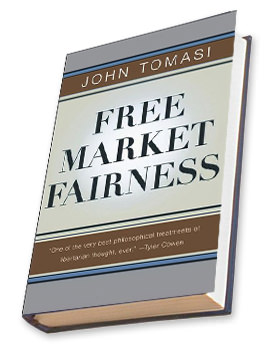John Tomasi in his book Free Market Fairness makes a case for ‘market democratic’ interpretation of social justice, which he sees as a morally superior account of social justice due to its commitment to both economic liberty and a fair distribution of goods and opportunities, as against the familiar ‘social democratic’ interpretations of social justice. Tomasi differentiates between the two regimes in his book as follows,
Social democratic regime types do not protect capitalist economic freedoms as basic constitutional rights. As a result, they empower legislative bodies to create and administer monopolies (or heavily regulated quasi-monopolies) in pursuit of socially desirable goods. The constitutional design of market democratic regime types, by contrast, encourages market-based forms of social construction. The market democratic emphasis on capitalistic economic liberties effectively limits the reach of legislative and administrative bureaucracies with respect to distributive issues.
Tomasi also elucidates the importance of decentralised decision making, choice, competition and innovation as seen in a market democratic regime; and its impact on education.
Market democratic regimes thus emphasize market mechanisms in pursuit of a superior system of education and health care for all. Instead of collectivizing decisions, the market democratic strategy is to create systems with the maximum number of decision points. By increasing choice and empowering people to make use of local information available only to them, such regimes aim to encourage innovation and improve performance on the part of the providers. By emphasizing individual choice making, such regimes encourage attitudes of personal awareness and responsibility on the part of ordinary citizens. By unleashing these forces, market democratic regimes hope to create a system that steadily drives up the quality of schooling and healthcare available to all.
Speaking generally, market democratic regimes prefer private over public forms of education, a preference that becomes ever stronger at higher levels of education. Such regime types seek to empower families to decide individually how much to spend on education and which type of school each of their children will attend (if they attend a school at all). By empowering families, market democratic regimes create an environment that encourages educational entrepreneurs to create novel and diverse forms of schooling. The government might play some oversight role in licensing schools and requiring that broad-gauged achievement standards be met.
In Tomasi’s market democratic world, choice for families/students and competition among service providers reign supreme.
The thrust of schooling within market democratic societies is toward a system of polycentric competition among providers and empowered decision making families.
School choice model of education, through provision of educational voucher to families who in turn spend vouchers at a school of their choice, is one such way of achieving the twin objectives of choice and competition. We delay our progress towards a market democratic society at our own peril.
——————————————————
PS: John Tomasi will be speaking tomorrow at the Asia Liberty Forum in New Delhi. His talk will be followed by book signing. For registration and other details, please contact: Srijan: ACE@ccs.in | +91-9953672130
Post Disclaimer
The opinions expressed in this essay are those of the authors. They do not purport to reflect the opinions or views of CCS.





